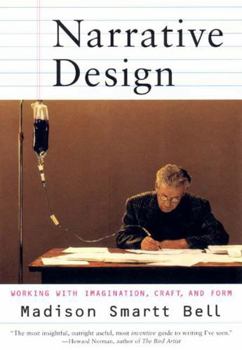Narrative Design: Working with Imagination, Craft, and Form
Select Format
Select Condition 
Book Overview
Focusing on the big picture as well as the crucial details, Bell examines twelve stories by both established writers (including Peter Taylor, Mary Gaitskill, and Carolyn Chute) and his own former students. A story's use of time, plot, character, and other elements of fiction are analyzed, and readers are challenged to see each story's flaws and strengths. Careful endnotes bring attention to the ways in which various writers use language. Bell urges...
Format:Paperback
Language:English
ISBN:0393320219
ISBN13:9780393320213
Release Date:April 2000
Publisher:W. W. Norton & Company
Length:392 Pages
Weight:1.20 lbs.
Dimensions:0.7" x 6.4" x 9.3"
Customer Reviews
3 ratings
Very helpful - an excellent book on the craft of fiction writing
Published by Thriftbooks.com User , 14 years ago
This book was very helpful--an excellent primer on the craft of fiction writing. One of the best things about the book is Madison Bell's close examination of several short stories by his former students.
A USEFUL fiction workshop in the palm of your hands.
Published by Thriftbooks.com User , 24 years ago
Finally! A book which not only gets to the heart of the"workshop" debate but also provides meaningful insights onwhat makes fiction work. On my shelf, this book has replaced Gardner's Art of Fiction as my bible for guidance in fiction writing.
Woodsheddin' with the T.Monk of American lit ...
Published by Thriftbooks.com User , 27 years ago
One of the country's best young authors provides an excellent textbook treatment of architectural matters lying at the heart of a writer's most basic concerns. Mr. Bell examines the invisible structures that underlie fiction. While emphasizing that "form is of first and final importance to any work ..." he also pays pleasurable attention to the writer's need for spontaneity, attending to the peculiar struggle battling in the mind of a writer that requires constant shifting between the right and left hemisphere's of the head. Happily, from the very beginning of the book, Mr. Bell makes plain his distaste for absolute, undying allegiance to form, and in a provocative essay, allows himself the pleasure of ruminating about self-hypnosis and rock 'n' roll in ways that stretch the reader's imagination as a warm-up before undertaking the very serious, quite detailed analytical dissections of a series of short stories that follow. The most significant aspect of Mr. Bell's analysis is that he points to two general methods of building narrative structures: one, he calls "linear design," which develops along the time continuum, the chronological flow of events with which we are all so familiar; and the second, which he calls "modular design" - a great form for non-fiction writers, I believe - which relies more on an arrangement of ideas, images, motifs or abstractions. In linear design, a writer would think of his or her material as a sculptor might, regarding one block of wood or granite by imagining the seemless, smooth shape that could be carved or chiseled out. The overall work - the long form with its distinct beginning, middle and end - is considered the most important single aspect of the piece. In modular design, however, the writer's effort is not aimed at whittling away at the block until the form beneath is clear, but at assembling bits and pieces, as one would a mosaic. Looking at the work from a distance, the writer would thoughtfully place these bits and pieces in a meaningful, aesthetically pleasing way, letting the natural contrast between pieces, speak to the whole. If linear design is essentially subtractive, Mr. Bell says, modular design is additive. In non-fiction, there are lots of great examples of this, such as Tracy Kidder's chapters on the lumber industry in his book "House." John McPhee has used this form, to a large extent, and to great success. Many essayists rely on modular design. The book is particularly enjoyable because of the form Mr. Bell has chosen. He relies on a wide range of stories, analyzed in detail, peppered with footnotes, to examine the structural choices of professional and student writers. Best of all, Mr. Bell writes wonderfully and playfully. His observation of writing structure as analogous to the underlying chords for jazz or rock 'n' roll improvisation is an example of his own ability to riff on a theme, compelling writers to have fun, to think seriously about the value





